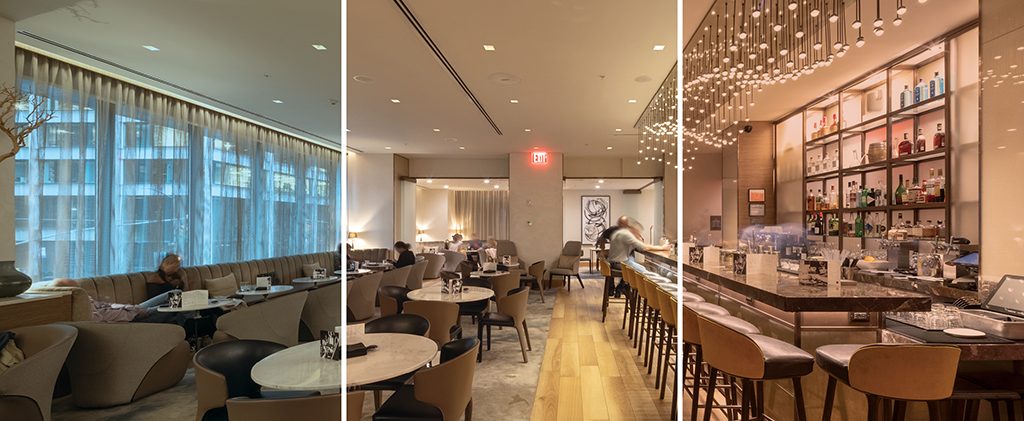How Does Tunable White Lighting Combat Jet Lag?

Lighting has always been critical for hotels and other hospitality settings.
For example, it’s instrumental in showcasing unique artwork and architecture. It also can make a cold, dingy room look warm, cozy and inviting.
But the importance of lighting for hospitality is starting to extend far beyond ambience and visual aesthetics.
It’s now a major tool for combating jetlag.
Thanks to tunable white lighting, architects and designers can now use this state-of-the-art type of lighting to make us feel good throughout the day and improve our health following a stressful, hours-long flight.
What is tunable white lighting? How does it treat jet lag?
How light controls circadian rhythms?
To understand tunable white lighting and its unmeasurable benefits, first, remember that our minds and bodies have a connection with the sun.
All living creatures and organisms—including animals, plants, insects and even single-celled bacteria—revolve around sunlight.
This rotation is called our circadian rhythm, which comprises the physical, mental and behavioral changes that occur in all of us over a 24-hour cycle.
The circadian rhythm is an automatic, built-in mechanism that, depending on the lightness and darkness of our immediate soundings, tells us what and when to do certain things. Sleeping at night and getting up in the day are prime examples.
That’s because the blue light spectrum from sunlight suppresses melatonin, a hormone that controls our daily sleep-wake cycles.
The formula is simple: less light = more melatonin = more sleep.
Before, artificial interior light could not mirror outdoor daylight’s natural sunlight or the innate body clock that it controls. Thanks to advancements in LED technology and lighting controls, it can today.
What is tunable white lighting?
At its most basic level, tunable white lighting is light that complements our natural circadian rhythms and mimics the sun. The technology adjusts to our daily rhythms by automatically changing the intensity and color temperature of a room, space or building’s interior light throughout the day.
Tunable white lighting systems give us the ability to control a light source’s color temperature output by emulating natural patterns of sunlight.
Cool-toned light emitting from a tunable white lighting system, especially at high intensity, suppresses melatonin, stimulates alertness and improves cognitive function.
Warm-toned light, on the other hand, encourages melatonin secretion and helps us relax. Exposure to amber light before bed can be very helpful in getting a good night’s sleep.
The ideal schedule of light exposure from such a system can vary depending on what one is trying to achieve. For a general guide, consider this: The rotation should start with bright, cool light in the morning that dims and warms throughout the day, with perhaps a cool light boost following lunchtime hours.
How tunable light helps with jet lag
Jetlag occurs when internal and external time clocks no longer match up. It’s the feeling of our circadian rhythm being off-kilter by traveling across time zones.
As a cause, it’s obvious how light impacts our internal clock. We are all used to it getting light or dark at a certain time. However, when we travel to someplace where it’s light when we’re used to it being dark, we get jetlagged.
Since light and darkness cycles are the principal cue for resetting circadian rhythms, both can by used to cure jetlag.
For instance, lights in a hotel or airport could be set to help long-distance travelers adjust to new time zones faster. Conversely, for very short trips where adjusting internal clocks isn’t needed, this lighting could help travelers maintain the rhythm of their native time zone.
This type of needed lightning gives hospitality spaces a unique opportunity to differentiate themselves and deliver a higher level of service.
How hotels and airports can use tunable lighting
Poor sleep is a perennial complaint among travelers. According to a study commissioned by IHG, 80% of travelers have trouble sleeping when they’re away from home.
One way that the hospitality industry can create the perfect gateway for their guests is to utilize tunable lighting systems that support healthy circadian rhythms. This would give guests a unique opportunity to biologically tune their lighting to sway their circadian clock and achieve a smoother recovery from travel.
The benefits of integrating a tunable white lighting system into rooms include:
- Decreasing guests’ fatigue from jetlag
- Improving guests’ alertness and mood
- Easing travelers’ adjustment to new time zones
- Improving customer satisfaction
- Reinforcing environmental commitments, since LEDs are more efficient, consume less power and help reduce carbon emissions
Tunable white lighting is important wherever humans are. Just ask NASA, which installed such a system on the International Space Station to help astronauts get better sleep.
A hotel’s fundamental purpose is to provide excellent service and a good night’s sleep. If a tunable white lighting system has proven to do both for some of the world’s best space travelers, it can do the same for jetlagged guests down below.
Want More?
If you have more questions, we have more answers:

